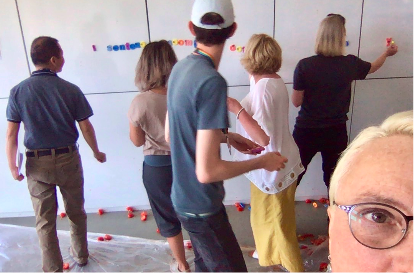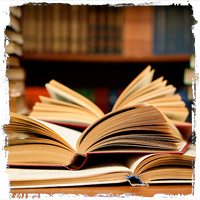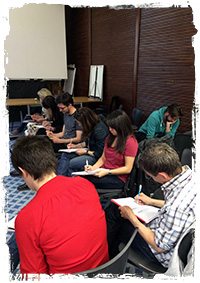Federica, Sam and Chris with me on the camera: Your PGR Team.
This conference presented a platform for researchers to explore how a methodology of Alchemy might offer insights as to where the hidden precious metals embedded in their work might be discovered. The theme encouraged a celebration of endeavours wrought in the hot white crucible of bold enquiry. This way sometimes leads us down worm holes however from an alchemical perspective it is messy imperfection that can potentially lead to an ‘ah ha’ moment. The generously sized venue in Parkside overlooking the University campus was divided into three areas: 1) relaxed exhibition/comfy interactive space, 2) traditional platform for presentations and 3) café. Delegates were welcomed to engage in a friendly environment. Goodie bags sporting re-usable cups, memory sticks and coffee tokens were distributed while Federica Mirra and myself (this year’s PGR assistant researchers) opened the day by introducing its playful aims. From then on, a rich mix of researchers masterminded a wealth of thought-provoking pathways and innovative interaction.
Our first session involved a fascinating project in which Emily Bettison and Hassan Hussain presented maps of the globe showing where PhDs in BCU and beyond study and present conferences. It was amazing to analyse the differing geographical distributions relating to areas of disciplines. Their research will enable PGR Studio to reach out to its community.
Hassan Hussain and Emily Bettison
For the second presentation we seamlessly moved into the activity space for a spine-chilling performance by Dr Andy Ingamells of He that plays the English gentleman shall be welcome. Dressed in cricket gear Andy questioned approaches to musical composition and performance and mimicked his speech by plucking a violin. Tomatoes in boxes that looked like alluring canapés were simultaneously distributed to us. Andy conveyed a friendly menacing air: “Throw the tomatoes at me” he goaded. Without any prompting we did and created a big mess! Out of the “canapés” fell numbered letters which we dutifully ordered into a cogent sentence explaining how we had created a piece of music!
The break featured 2 breakout activities: My ‘alchemical lucky dip’ whereby people chose an object and randomly matched it with a written message to find a synchronistic message, and Matt Evans’s interactive audio-visual installation Collide, which featured fabulous abstract moving images and sound activated by an interactive vest. Next up Dr Tam Alfahal presented Enactment of thinking: creative explorations in research with an exhibition of her exquisite artwork. Tam integrates contemporary Islamic design with an aesthetic reading of traditional Islamic philosophy. This fusion was superbly demonstrated by incorporating into her beautifully presented thesis the ancient method of marking the progress of pages in a book via a symbol in the margins. Dr Paul Norman then engaged us with the philosophy of what is musical composition by delivering a provocation of exceptional erudition: What is it, this that I am doing? – Reading as a compositional act.
He that plays the English gentleman shall be welcome Dr Andy Ingamells
The break featured 2 breakout activities: My ‘alchemical lucky dip’ whereby people chose an object and randomly matched it with a written message to find a synchronistic message, and Matt Evans’s interactive audio-visual installation Collide, which featured fabulous abstract moving images and sound activated by an interactive vest. Next up Dr Tam Alfahal presented Enactment of thinking: creative explorations in research with an exhibition of her exquisite artwork. Tam integrates contemporary Islamic design with an aesthetic reading of traditional Islamic philosophy. This fusion was superbly demonstrated by incorporating into her beautifully presented thesis the ancient method of marking the progress of pages in a book via a symbol in the margins. Dr Paul Norman then engaged us with the philosophy of what is musical composition by delivering a provocation of exceptional erudition: What is it, this that I am doing? – Reading as a compositional act.
Dr Paul Norman
The morning concluded with Pouring oil on to troubled waters? Alchemies of choral composition by Dr Edmund Hunt in which he played us extracts of his stunning new choral work composed in collaboration with an amateur choir. His interface with them provided the philosopher’s stone that transformed seemingly simple ideas into gold. Over now to my colleague Federica to give an account of all the wonderful presentations after lunch. I very much look forward to engaging with your work next term. Have a great summer!
On the set for my experimental work Analysis
Read Alchemies of Research Part II by Federica Mirra
Read Alchemies of Research Part III by Georgina Garbett
Check out the original Call for Proposals here



